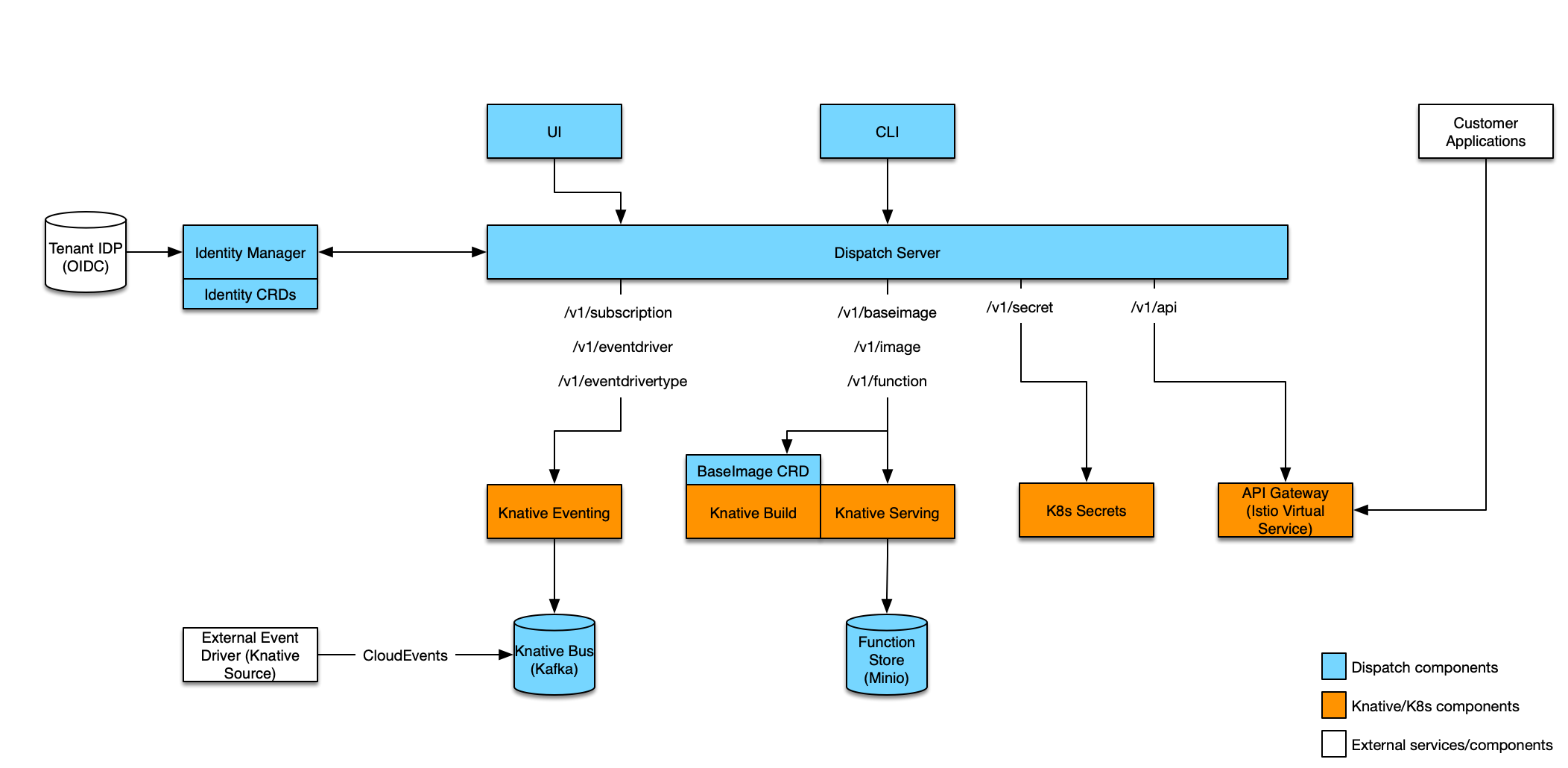vmware-archive / Dispatch
Programming Languages
Projects that are alternatives of or similar to Dispatch
IMPORTANT: VMware has ended active development of this project, this repository will no longer be updated.
NOTE: This is the knative branch of Dispatch. Full Dispatch functionality is still a ways off. The code here represents a work in progress. For information about Dispatch Solo, the version of Dispatch distributed as an OVA, see the
solobranch or documentation.
Dispatch is a framework for deploying and managing serverless style applications. The intent is a framework which enables developers to build applications which are defined by functions which handle business logic and services which provide all other functionality:
- State (Databases)
- Messaging/Eventing (Queues)
- Ingress (Api-Gateways)
- Etc.
Our goal is to provide a substrate which can be built upon and extended to serve as a framework for serverless applications. Additionally, the framework must provide tools and features which aid the developer in building, debugging and maintaining their serverless application.
Documentation
Checkout the detailed documentation including a quickstart guide.
Architecture
NOTE: The information in this section is specific to the knative branch of Dispatch. Equivalent documentation for Dispatch Solo can be found on the
solobranch.
The diagram below illustrates the different components which make up the Dispatch project:
Installation
NOTE: The information in this section is specific to the knative branch of Dispatch. Equivalent documentation for Dispatch Solo can be found on the
solobranch.
Prerequisites
GKE
-
export GCLOUD_KEY=<path to key.json>
-
Create GKE cluster:
K8S_VERSION=1.10.7-gke.6 export CLUSTER_NAME=dispatch-knative gcloud container clusters create -m n1-standard-4 --cluster-version ${K8S_VERSION} ${CLUSTER_NAME} gcloud container clusters get-credentials ${CLUSTER_NAME}
-
Install Knative:
# Get the current knative verision used with dispatch KNATIVE_VERSION=$(cat Gopkg.toml | grep -A 2 'name = "github.com/knative/serving"' | grep revision | cut -d '"' -f2) ./scripts/install-knative.py ${CLUSTER_NAME} --gcloud-key=${GCLOUD_KEY} --revision=${KNATIVE_VERSION}
VMware Cloud PKS
-
Create a Cloud PKS cluster with privileged mode enabled.
export VKE_CLUSTER=dispatch-knative vke cluster create --privilegedMode --name $VKE_CLUSTER --cluster-type PRODUCTION --region us-west-2
-
Get kubectl credentials:
vke cluster auth setup $VKE_CLUSTER -
Install Knative:
- Install Istio:
kubectl apply -f third-party/vmware-cloud-pks/istio-1.0.2/istio.yaml - Wait for Istio pods to become READY (will take a little while to scale up smart cluster):
kubectl get pods -n istio-system NAME READY STATUS RESTARTS AGE istio-citadel-746c765786-2cm5p 1/1 Running 0 6m istio-cleanup-secrets-vbqk7 0/1 Completed 0 6m istio-egressgateway-57df84cfcf-hpkx4 1/1 Running 0 6m istio-galley-5b4f774c-9gcqm 1/1 Running 0 6m istio-ingressgateway-76dbd65c-7qf2w 1/1 Running 0 6m istio-pilot-7ddfbdf465-cj5jl 2/2 Running 0 6m istio-policy-56789fbb8c-flxkz 2/2 Running 0 6m istio-statsd-prom-bridge-7c77ddc9b9-s2zwl 1/1 Running 0 6m istio-telemetry-855bb88878-kbhsj - Install Knative serving (includes build):
kubectl apply -f third-party/vmware-cloud-pks/serving-0.2.2/release.yaml
- Install Istio:
Other
In order to install Knative, follow the development instructions
Dispatch
Installing Dispatch depends on having a Kubernetes cluster with the Knative components installed (Build, Serving and soon Eventing). From here build and install dispatch as follows:
-
Set the following environment variables:
export DISPATCH_NAMESPACE="default" export DISPATCH_DEBUG="true" export RELEASE_NAME="dispatch" export MINIO_USERNAME="dispatch" export MINIO_PASSWORD="dispatch" export INGRESS_IP=$(kubectl get service -n istio-system knative-ingressgateway -o wide | tail -n1 | awk '{print $4}')
-
Build and publish a dispatch image (Substitute in your docker repository):
Note: if you just want to use a pre-created image use the script to create your
values.yamland continue to step 4.TAG="v0.1.22-knative" ./scripts/values.sh
DISPATCH_SERVER_DOCKER_REPOSITORY=<docker repository username> PUSH_IMAGES=1 make images
-
The previous command will output a configuration file
values.yaml:image: host: username tag: v0.1.xx registry: url: http://dispatch-docker-registry:5000/ repository: dispatch-docker-registry:5000 storage: minio: address: dispatch-minio:9000 username: ******** password: ********
-
Deploy via helm chart (if helm is not installed and initialized, do that first):
helm init --wait # helm won't overwrite the existing config-maps (at least not the first/install time), so explicitly delete them. kubectl delete configmap -n knative-serving config-domain config-network helm dependency build ./charts/dispatch/ helm upgrade -i --debug ${RELEASE_NAME} ./charts/dispatch --namespace ${DISPATCH_NAMESPACE} -f values.yaml
NOTE: Use following to create cluster role binding for tiller:
kubectl create clusterrolebinding tiller-cluster-admin --clusterrole=cluster-admin --serviceaccount=kube-system:default
-
Reconfigure Knative serving (need to whitelist our internal repository):
./scripts/configure-knative.sh
-
Build the CLI (substitute darwin for linux if needed):
make cli-darwin # Create symlink to binary ln -s `pwd`/bin/dispatch-darwin /usr/local/bin/dispatch
-
Create the Dispatch config:
cat << EOF > config.json { "current": "${RELEASE_NAME}", "contexts": { "${RELEASE_NAME}": { "host": "$(kubectl -n ${DISPATCH_NAMESPACE} get service ${RELEASE_NAME}-nginx-ingress-controller -o wide | tail -n1 | awk '{print $4}')", "port": 443, "scheme": "https", "insecure": true } } } EOF # point to the config file (could also move to ~/.dispatch/config) export DISPATCH_CONFIG=`pwd`/config.json
-
Test out your install: First, create an baseimage:
dispatch create base-image python3-base dispatchframework/python3-base:0.0.13-knative Created baseimage: python3-base
Then, create an image:
dispatch create image python3 python3-base Created image: python3
Wait for status READY:
dispatch get images NAME | DESTINATION | BASEIMAGE | STATUS | CREATED DATE -------------------------------------------------------------------------- python3 | *********** | ********* | READY | Tue Sep 25 16:51:35 PDT 2018
Create a function:
dispatch create function --image python3 hello ./examples/python3/hello.py Created function: hello
Once status is READY:
dispatch get function NAME | FUNCTIONIMAGE | STATUS | CREATED DATE ---------------------------------------------------------------- hello | ************* | READY | Thu Sep 13 12:41:07 PDT 2018
Exec the function:
dispatch exec hello <<< '{"name": "user"}' | jq . { "context": { "logs": { "stdout": [ "messages to stdout show up in logs" ], "stderr": null } }, "payload": { "myField": "Hello, user from Nowhere" } }
Create an endpoint:
dispatch create endpoint get-hello hello --method GET --method POST --path /hello
Hit the endpoint with curl:
curl -v http://${INGRESS_IP}/hello?name=Jon -H 'Host: default.${DISPATCH_NAMESPACE}.dispatch.local'
For a more complete quickstart see the developer documentation


